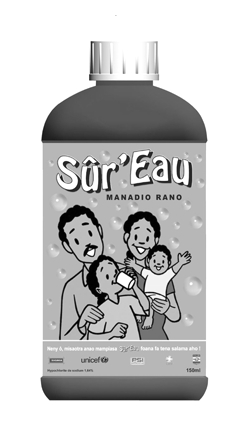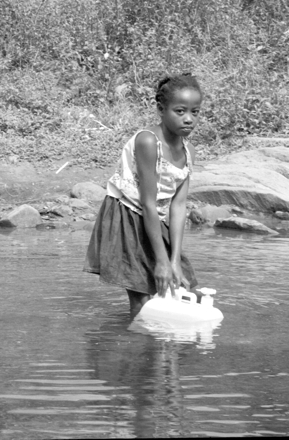Abstract
Rural populations disproportionately lack access to improved water supplies. We evaluated a novel scheme that employed community-based sales agents to disseminate the Safe Water System (SWS)—a household-level water chlorination and safe storage intervention—in rural Madagascar.
Respondents from 242 households in 4 villages were interviewed; all used surface water for drinking water. Respondents from 239 households (99%) had heard of Sûr’Eau, the SWS disinfectant; 226 (95%) reported having ever used Sûr’Eau, and 166 (73%) reported current use. Current Sûr’Eau use was confirmed in 54% of households. Community sales agents effectively motivated their neighbors to adopt a new health behavior that prevents diarrhea.
Future work should focus on strategies for sustaining SWS use, factors that motivate community-based sales agents to promote SWS, and the feasibility of scaling up this approach.
AMONG THE 1 BILLION persons estimated to lack access to improved water sources worldwide, rural populations are disproportionately underserved. The World Health Organization estimated that in 2000, 94% of the world’s urban population had access to improved water sources compared with just 71% of rural populations1; that year, only 34% of Madagascar’s rural population was estimated to have access to improved water sources.2 The low population density, remoteness of the population, difficult terrain, and relative political disenfranchisement of rural areas have resulted in a much lower investment in improved water sources despite greater need.1
In 2000, Population Services International initiated a social marketing campaign to promote the Safe Water System (SWS; see the box on the next page)—a household water quality intervention for diarrhea prevention—in Madagascar. Many isolated rural communities that lacked access to mass media were not reached by the campaign. In August 2001, CARE Madagascar launched a project to increase access to the SWS in the remote rural communities of eastern Madagascar by motivating community-based sales agents to sell both the diluted chlorine solution, which bears the brand name Sûr’Eau, and jerry cans with taps (Figure 1 ▶).
FIGURE 1—

Sûr’Eau water disinfectant, Madagascar, 2002.
PROGRAM DESCRIPTION
The 4 target villages in eastern Tamatave Province were extremely remote. Villagers had little contact with nongovernmental or other organizations; thus, they had no previous exposure to the SWS social marketing campaign. A radio was available in only 1 or 2 homes, typically the wealthiest households, in each village. CARE trained 1 community-based sales agent in each village on causes and prevention of diarrhea, proper use of the SWS, and techniques for changing health behaviors. The agents visited their neighbors to educate them about the need for household water treatment and safe storage to prevent diarrhea and to sell them Sûr’Eau and jerry cans with taps. Each bottle of Sûr’Eau was sold for $0.33 and treated about 1000 liters of water, which lasted about 6 weeks for a family of 4; each jerry can with a tap was sold for about $3.
EVALUATION AND DISCUSSION
In November 2002, we evaluated CARE Madagascar’s SWS campaign in the 4 Tamatave Province villages. We conducted a cross-sectional survey by interviewing 1 consenting respondent from each household in each village to assess knowledge and self-reported use of Sûr’Eau and other water-handling practices. Most villagers had 1 home in the village and a shelter near their fields, hereafter referred to as an encampment; each encampment was isolated from other encampments. To verify Sûr’Eau use among households that reported current use, we conducted surprise visits to encampments. Because the evaluation team had to travel by foot, surprise visits were limited to encampments within a 1-hour walk from the village. During the visits, field workers tested water that was reported to have been treated with Sûr’Eau for residual chlorine with a colorimetric method (Hach Co, Loveland, Colo). Confirmed Sûr’Eau use was defined as detection of total chlorine at concentrations greater than 0.1 mg/L.
Interviews were conducted with respondents from 242 households, who represented a population of 1385 persons. The median age of the population was 12 years (0–90 years); 22% were younger than 5 years. The female head of household was reported to be literate in 51% of households. Overall, 215 households (89%) lived in encampments. All used surface water for drinking water; 186 households (77%) stored water in a wide-mouthed vessel, such as a bucket, and 38 households (15%) stored water in jerry cans with taps (Figure 2 ▶).
FIGURE 2—

Girl collecting water in jerry can for safe water storage, Madagascar, 2002.
Of the 242 respondents, 239 (99%) had heard of Sûr’Eau, and of those, 233 (98%) had heard about Sûr’Eau from CARE staff or community-based sales agents. Of the 226 respondents (95%) who reported having ever used Sûr’Eau, 166 (73%) reported current use. The most common reasons for discontinuation of Sûr’Eau use among previous users were (1) they had used up the bottle (52%), (2) they had no money (17%), and (3) the expiration date on the bottle had passed (12%). There was no association between literacy of the female head of household and self-reported use of Sûr’Eau. Additionally, there was no association between per capita daily rice consumption, which was recommended by villagers and community leaders as a useful proxy for wealth, and self-reported current use of Sûr’Eau.
Of the 166 self-reported users of Sûr’Eau, 119 (72%) were able to correctly state the proper dose of Sûr’Eau, the waiting time before drinking the treated water, and the proper water storage procedure. Knowledge of correct Sûr’Eau use did not vary by literacy or by per capita rice consumption. In 133 households of self-reported current users (80%), interviewers observed a Sûr’Eau bottle. A total of 121 (73%) self-reported users of Sûr’Eau reported having an encampment near their fields. During surprise visits to the encampments of 66 self-reported users (55%), we confirmed Sûr’Eau use in 29 (54%) of 54 households that were storing water at the time of the surprise visit (Table 1 ▶).
TABLE 1—
Sûr’Eau Use in Encampments: Tamatave Province, Madagascar, 2002
| Self-reported Sûr’Eau users | N = 166 |
| Self-reported Sûr’Eau users who lived in encampments, no. (%) | 121/166 (73%) |
| Surprise visit to encampment successfully completed, no. (%) | 66/121 (55%) |
| Water stored at time of surprise visit, no. (%) | 54/66 (82%) |
| Stored water reported to have been treated at time of surprise visit, no. (%) | 30/54 (56%) |
| Stored water confirmed to have chlorine at time of surprise visit, no. (%) | 29/54 (54%) |
KEY FINDINGS.
Almost all villagers were aware of the household disinfection strategy, and this knowledge was similar across literacy and socioeconomic strata.
Use of Sûr’Eau was confirmed in about one half of encampments of self-reported users, which shows the portability of the intervention.
Jerry cans with taps were used by a minority of the target population.
THE SAFE WATER SYSTEM (SWS).
The Safe Water System (SWS) is a household-level technology for improving the quality of drinking water and reducing the risk for diarrheal disease. The intervention has 3 components: water disinfection with a diluted chlorine solution at the point of use, safe water storage, and behavior-change techniques to enhance adoption of the household disinfection. These techniques include social marketing, community mobilization, and microentrepreneur strategies.
Use of the SWS results in improved water quality3,4 and reduced diarrheal disease risk.5–8 More than 20 countries in Africa, Asia, and Latin America and the Caribbean have regional or national SWS programs. Additional information is available at http://www.cdc.gov/safewater.
Our evaluation showed that a remote rural population can be motivated to purchase and to use an inexpensive water disinfection product that prevents diarrhea. Community-based sales agents communicated health messages effectively and accurately to neighbors who had varying financial and literacy statuses. We found a high rate of Sûr’Eau adoption among villagers who lived in encampments, which confirmed that this simple tool for household water disinfection can be easily transported to remote locations. Yet, only about half of self-reported users were confirmed to be users of Sûr’Eau during surprise visits, with cost identified as a barrier by 17% of those who discontinued using Sûr’Eau. Because of intensive community mobilization by CARE and the community-based sales agents, interviewees may have been reticent to discuss true reasons for discontinuing use. The smell and the taste of chlorinated water may have been a barrier to sustained use of Sûr’Eau among a chlorine-naive (never having come into contact with chlorinated water) population, although this was not reported during the interviews. The evaluation was conducted as a cross-sectional survey, and we did not follow the population over time; thus, we cannot comment on the change in use during the course of the CARE project. A minority of families (15%) purchased the safe water storage containers that the campaign promoted, perhaps because of cost or resistance to using plastic containers instead of bamboo poles, which are the indigenous water storage containers.
Among remote populations who are unlikely to receive improved water sources in the near future, the SWS is a portable tool for improving water quality in the household. This model could be adapted to include additional low-cost health products and thereby expand the community-based sales agents’ health impact on these isolated communities.
NEXT STEPS
Although the community-based sales agent model can be effective for dissemination of the SWS strategy, it should be further improved to achieve sustained use of the SWS among target populations. Future evaluations should address reasons for adoption and discontinuation of SWS use, factors that motivate community-based sales agents, and the ability of this approach to be scaled up and sustained.
Acknowledgments
We received funding contributions from the US Agency for International Development, UNICEF, John Snow International, and the Chlorine Chemistry Council for Projet Ranomadio, which included this SWS campaign.
Our deepest appreciation goes to the families who participated in the evaluation and who struggle daily for the most basic of life’s necessities. The following research assistants contributed remarkable dedication and humor to the evaluation, having walked through many a muddy field to collect data: Rakotonjanahary Serge Kenny, Rakotondrazaka Daniela, Ianitra Bonne Aimee Florencine, Norotiana Genestine Francesse, Rabearisoa Jojo Christian Olivier, Toaly Angela, Raharimiaja Ndraibe Amelie Gastella, and Rasoamitandrina Odile.
Human Participant Protection This study protocol was deemed to be exempt from institutional review by the Human Research Protection Office of the Centers for Disease Control and Prevention.
Peer Reviewed
Contributors P.K. Ram, E. Kelsey, and R.E. Quick designed, conducted, and analyzed the evaluation. Rasoatiana, R. Miarintsoa, and O. Rakotomalala assisted with conducting the evaluation. C. Dunston assisted with the design and the analysis. All authors contributed to writing the article.
References
- 1.Global Water Supply and Sanitation Assessment 2000 Report. Geneva, Switzerland:World Health Organization & United Nations Children’s Fund; 2000.
- 2.UNICEF. Madagascar. Available at: http://www.unicef.org/infobycountry/madagascar.html. Accessed November 29, 2006.
- 3.Luby S, Agboatwalla M, Raza A, et al. A low-cost intervention for cleaner drinking water in Karachi, Pakistan. Int J Infect Dis. 2001;5:144–150. [DOI] [PubMed] [Google Scholar]
- 4.Quick R, Venczel L, Gonzalez O, et al. Narrow-mouthed water storage vessels and in situ chlorination in a Bolivian community: a simple method to improve drinking water quality. Am J Trop Med Hyg. 1996;54:511–516. [DOI] [PubMed] [Google Scholar]
- 5.Quick RE, Kimura A, Thevos A, et al. Diarrhea prevention through household-level water disinfection and safe storage in Zambia. Am J Trop Med Hyg. 2002;66:584–589. [DOI] [PubMed] [Google Scholar]
- 6.Quick RE, Venczel LV, Mintz ED, et al. Diarrhoea prevention in Bolivia through point-of-use water treatment and safe storage: a promising new strategy. Epidemiol Infect. 1999;122:83–90. [DOI] [PMC free article] [PubMed] [Google Scholar]
- 7.Roberts L, Chartier Y, Chartier O, Malenga G, Toole M, Rodka H. Keeping clean water clean in a Malawi refugee camp: a randomized intervention trial. Bull World Health Organ. 2001;79: 280–287. [PMC free article] [PubMed] [Google Scholar]
- 8.Semenza JC, Roberts L, Henderson A, Bogan J, Rubin CH. Water distribution system and diarrheal disease transmission: a case study in Uzbekistan. Am J Trop Med Hyg. 1998;59:941–946. [DOI] [PubMed] [Google Scholar]


